Application of Primary Health Care Concepts and Health Promotion
VerifiedAdded on 2022/09/26
|7
|2009
|18
Report
AI Summary
This report examines the application of Primary Health Care (PHC) concepts and health promotion strategies within an Indigenous Australian community, drawing on the video "It takes a village." The analysis addresses key social determinants of health, including social support networks and education, highlighting their impact on community well-being. The report explores the principles of public participation and accessibility in healthcare, emphasizing community involvement and equitable service delivery. Furthermore, it discusses the significance of a supportive environment for health, encompassing social and physical aspects, and underscores the importance of cultural competence in healthcare practices. The report uses examples from the video to illustrate how these concepts are implemented and their positive outcomes in the community. The report references relevant literature to support its findings and conclusions.

Nursing
Student’s name:
Institutional:
Student’s name:
Institutional:
Paraphrase This Document
Need a fresh take? Get an instant paraphrase of this document with our AI Paraphraser
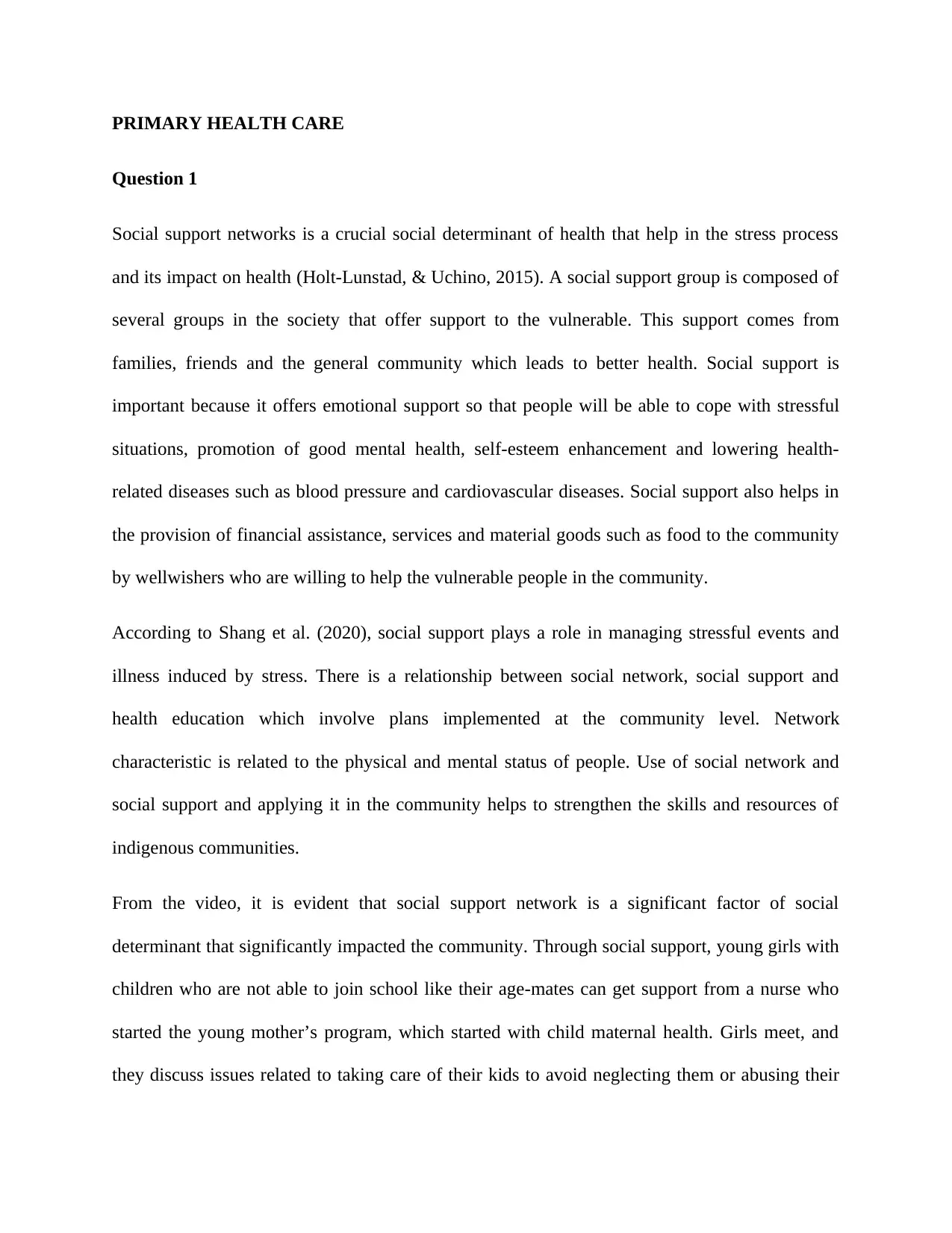
PRIMARY HEALTH CARE
Question 1
Social support networks is a crucial social determinant of health that help in the stress process
and its impact on health (Holt-Lunstad, & Uchino, 2015). A social support group is composed of
several groups in the society that offer support to the vulnerable. This support comes from
families, friends and the general community which leads to better health. Social support is
important because it offers emotional support so that people will be able to cope with stressful
situations, promotion of good mental health, self-esteem enhancement and lowering health-
related diseases such as blood pressure and cardiovascular diseases. Social support also helps in
the provision of financial assistance, services and material goods such as food to the community
by wellwishers who are willing to help the vulnerable people in the community.
According to Shang et al. (2020), social support plays a role in managing stressful events and
illness induced by stress. There is a relationship between social network, social support and
health education which involve plans implemented at the community level. Network
characteristic is related to the physical and mental status of people. Use of social network and
social support and applying it in the community helps to strengthen the skills and resources of
indigenous communities.
From the video, it is evident that social support network is a significant factor of social
determinant that significantly impacted the community. Through social support, young girls with
children who are not able to join school like their age-mates can get support from a nurse who
started the young mother’s program, which started with child maternal health. Girls meet, and
they discuss issues related to taking care of their kids to avoid neglecting them or abusing their
Question 1
Social support networks is a crucial social determinant of health that help in the stress process
and its impact on health (Holt-Lunstad, & Uchino, 2015). A social support group is composed of
several groups in the society that offer support to the vulnerable. This support comes from
families, friends and the general community which leads to better health. Social support is
important because it offers emotional support so that people will be able to cope with stressful
situations, promotion of good mental health, self-esteem enhancement and lowering health-
related diseases such as blood pressure and cardiovascular diseases. Social support also helps in
the provision of financial assistance, services and material goods such as food to the community
by wellwishers who are willing to help the vulnerable people in the community.
According to Shang et al. (2020), social support plays a role in managing stressful events and
illness induced by stress. There is a relationship between social network, social support and
health education which involve plans implemented at the community level. Network
characteristic is related to the physical and mental status of people. Use of social network and
social support and applying it in the community helps to strengthen the skills and resources of
indigenous communities.
From the video, it is evident that social support network is a significant factor of social
determinant that significantly impacted the community. Through social support, young girls with
children who are not able to join school like their age-mates can get support from a nurse who
started the young mother’s program, which started with child maternal health. Girls meet, and
they discuss issues related to taking care of their kids to avoid neglecting them or abusing their
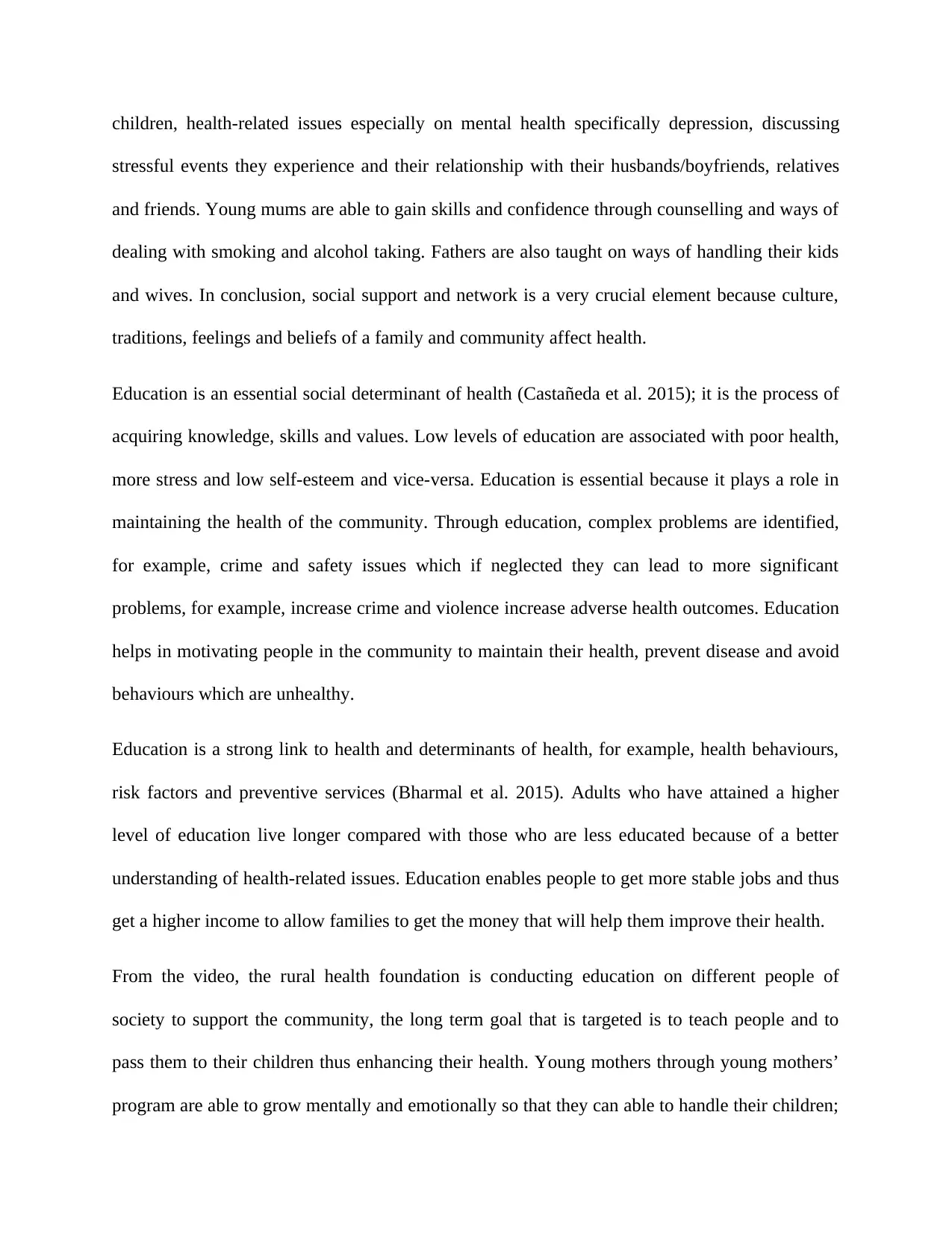
children, health-related issues especially on mental health specifically depression, discussing
stressful events they experience and their relationship with their husbands/boyfriends, relatives
and friends. Young mums are able to gain skills and confidence through counselling and ways of
dealing with smoking and alcohol taking. Fathers are also taught on ways of handling their kids
and wives. In conclusion, social support and network is a very crucial element because culture,
traditions, feelings and beliefs of a family and community affect health.
Education is an essential social determinant of health (Castañeda et al. 2015); it is the process of
acquiring knowledge, skills and values. Low levels of education are associated with poor health,
more stress and low self-esteem and vice-versa. Education is essential because it plays a role in
maintaining the health of the community. Through education, complex problems are identified,
for example, crime and safety issues which if neglected they can lead to more significant
problems, for example, increase crime and violence increase adverse health outcomes. Education
helps in motivating people in the community to maintain their health, prevent disease and avoid
behaviours which are unhealthy.
Education is a strong link to health and determinants of health, for example, health behaviours,
risk factors and preventive services (Bharmal et al. 2015). Adults who have attained a higher
level of education live longer compared with those who are less educated because of a better
understanding of health-related issues. Education enables people to get more stable jobs and thus
get a higher income to allow families to get the money that will help them improve their health.
From the video, the rural health foundation is conducting education on different people of
society to support the community, the long term goal that is targeted is to teach people and to
pass them to their children thus enhancing their health. Young mothers through young mothers’
program are able to grow mentally and emotionally so that they can able to handle their children;
stressful events they experience and their relationship with their husbands/boyfriends, relatives
and friends. Young mums are able to gain skills and confidence through counselling and ways of
dealing with smoking and alcohol taking. Fathers are also taught on ways of handling their kids
and wives. In conclusion, social support and network is a very crucial element because culture,
traditions, feelings and beliefs of a family and community affect health.
Education is an essential social determinant of health (Castañeda et al. 2015); it is the process of
acquiring knowledge, skills and values. Low levels of education are associated with poor health,
more stress and low self-esteem and vice-versa. Education is essential because it plays a role in
maintaining the health of the community. Through education, complex problems are identified,
for example, crime and safety issues which if neglected they can lead to more significant
problems, for example, increase crime and violence increase adverse health outcomes. Education
helps in motivating people in the community to maintain their health, prevent disease and avoid
behaviours which are unhealthy.
Education is a strong link to health and determinants of health, for example, health behaviours,
risk factors and preventive services (Bharmal et al. 2015). Adults who have attained a higher
level of education live longer compared with those who are less educated because of a better
understanding of health-related issues. Education enables people to get more stable jobs and thus
get a higher income to allow families to get the money that will help them improve their health.
From the video, the rural health foundation is conducting education on different people of
society to support the community, the long term goal that is targeted is to teach people and to
pass them to their children thus enhancing their health. Young mothers through young mothers’
program are able to grow mentally and emotionally so that they can able to handle their children;
⊘ This is a preview!⊘
Do you want full access?
Subscribe today to unlock all pages.

Trusted by 1+ million students worldwide
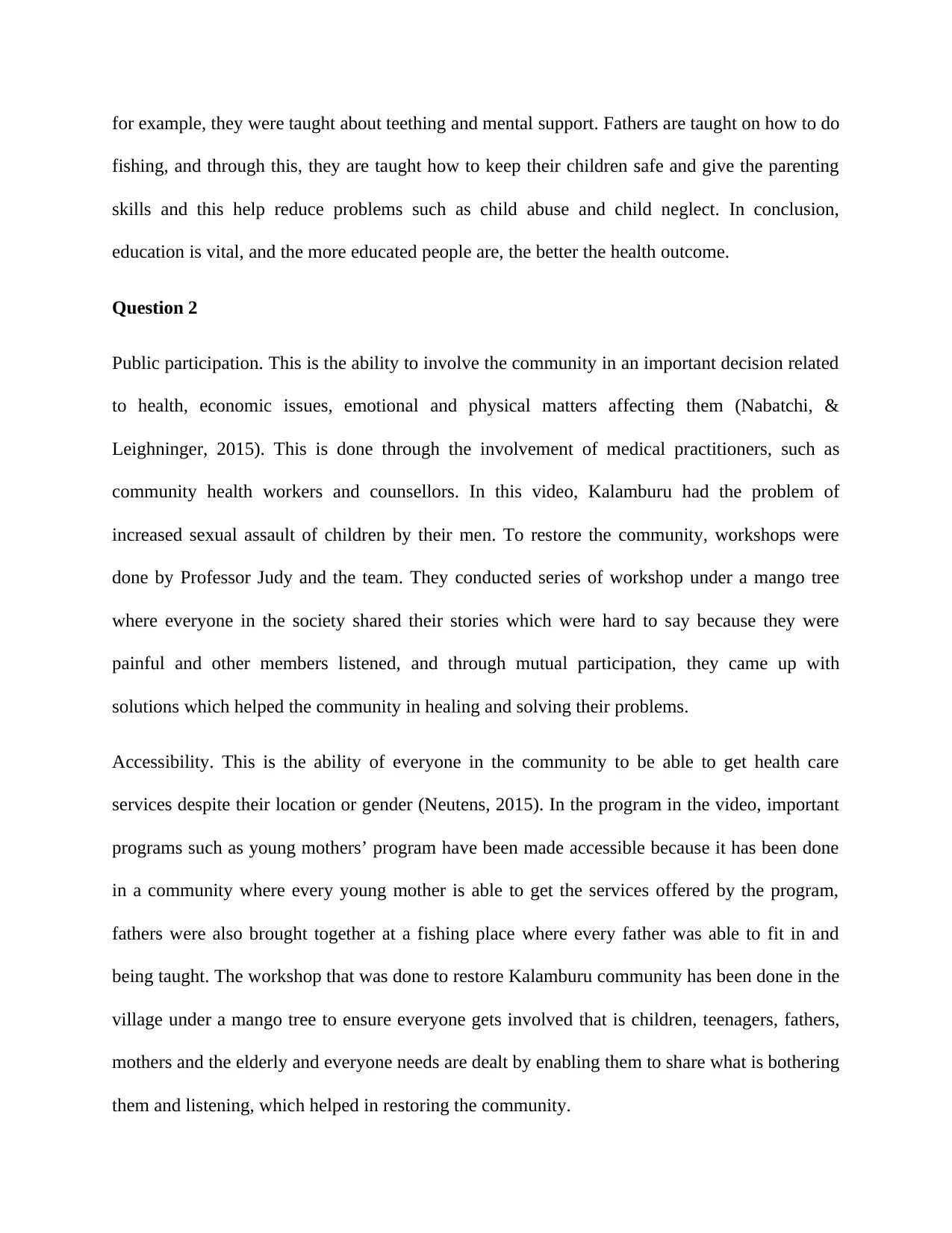
for example, they were taught about teething and mental support. Fathers are taught on how to do
fishing, and through this, they are taught how to keep their children safe and give the parenting
skills and this help reduce problems such as child abuse and child neglect. In conclusion,
education is vital, and the more educated people are, the better the health outcome.
Question 2
Public participation. This is the ability to involve the community in an important decision related
to health, economic issues, emotional and physical matters affecting them (Nabatchi, &
Leighninger, 2015). This is done through the involvement of medical practitioners, such as
community health workers and counsellors. In this video, Kalamburu had the problem of
increased sexual assault of children by their men. To restore the community, workshops were
done by Professor Judy and the team. They conducted series of workshop under a mango tree
where everyone in the society shared their stories which were hard to say because they were
painful and other members listened, and through mutual participation, they came up with
solutions which helped the community in healing and solving their problems.
Accessibility. This is the ability of everyone in the community to be able to get health care
services despite their location or gender (Neutens, 2015). In the program in the video, important
programs such as young mothers’ program have been made accessible because it has been done
in a community where every young mother is able to get the services offered by the program,
fathers were also brought together at a fishing place where every father was able to fit in and
being taught. The workshop that was done to restore Kalamburu community has been done in the
village under a mango tree to ensure everyone gets involved that is children, teenagers, fathers,
mothers and the elderly and everyone needs are dealt by enabling them to share what is bothering
them and listening, which helped in restoring the community.
fishing, and through this, they are taught how to keep their children safe and give the parenting
skills and this help reduce problems such as child abuse and child neglect. In conclusion,
education is vital, and the more educated people are, the better the health outcome.
Question 2
Public participation. This is the ability to involve the community in an important decision related
to health, economic issues, emotional and physical matters affecting them (Nabatchi, &
Leighninger, 2015). This is done through the involvement of medical practitioners, such as
community health workers and counsellors. In this video, Kalamburu had the problem of
increased sexual assault of children by their men. To restore the community, workshops were
done by Professor Judy and the team. They conducted series of workshop under a mango tree
where everyone in the society shared their stories which were hard to say because they were
painful and other members listened, and through mutual participation, they came up with
solutions which helped the community in healing and solving their problems.
Accessibility. This is the ability of everyone in the community to be able to get health care
services despite their location or gender (Neutens, 2015). In the program in the video, important
programs such as young mothers’ program have been made accessible because it has been done
in a community where every young mother is able to get the services offered by the program,
fathers were also brought together at a fishing place where every father was able to fit in and
being taught. The workshop that was done to restore Kalamburu community has been done in the
village under a mango tree to ensure everyone gets involved that is children, teenagers, fathers,
mothers and the elderly and everyone needs are dealt by enabling them to share what is bothering
them and listening, which helped in restoring the community.
Paraphrase This Document
Need a fresh take? Get an instant paraphrase of this document with our AI Paraphraser
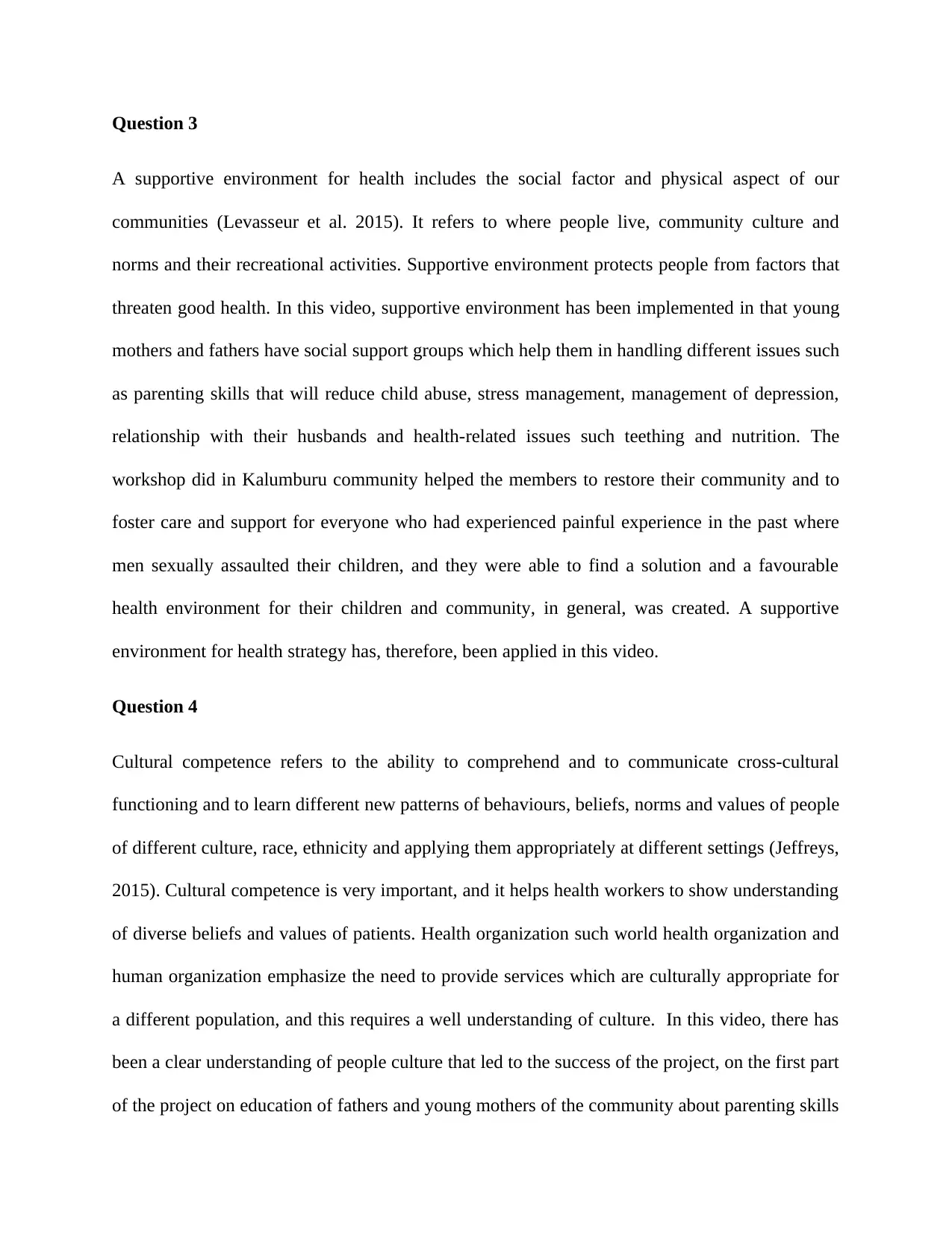
Question 3
A supportive environment for health includes the social factor and physical aspect of our
communities (Levasseur et al. 2015). It refers to where people live, community culture and
norms and their recreational activities. Supportive environment protects people from factors that
threaten good health. In this video, supportive environment has been implemented in that young
mothers and fathers have social support groups which help them in handling different issues such
as parenting skills that will reduce child abuse, stress management, management of depression,
relationship with their husbands and health-related issues such teething and nutrition. The
workshop did in Kalumburu community helped the members to restore their community and to
foster care and support for everyone who had experienced painful experience in the past where
men sexually assaulted their children, and they were able to find a solution and a favourable
health environment for their children and community, in general, was created. A supportive
environment for health strategy has, therefore, been applied in this video.
Question 4
Cultural competence refers to the ability to comprehend and to communicate cross-cultural
functioning and to learn different new patterns of behaviours, beliefs, norms and values of people
of different culture, race, ethnicity and applying them appropriately at different settings (Jeffreys,
2015). Cultural competence is very important, and it helps health workers to show understanding
of diverse beliefs and values of patients. Health organization such world health organization and
human organization emphasize the need to provide services which are culturally appropriate for
a different population, and this requires a well understanding of culture. In this video, there has
been a clear understanding of people culture that led to the success of the project, on the first part
of the project on education of fathers and young mothers of the community about parenting skills
A supportive environment for health includes the social factor and physical aspect of our
communities (Levasseur et al. 2015). It refers to where people live, community culture and
norms and their recreational activities. Supportive environment protects people from factors that
threaten good health. In this video, supportive environment has been implemented in that young
mothers and fathers have social support groups which help them in handling different issues such
as parenting skills that will reduce child abuse, stress management, management of depression,
relationship with their husbands and health-related issues such teething and nutrition. The
workshop did in Kalumburu community helped the members to restore their community and to
foster care and support for everyone who had experienced painful experience in the past where
men sexually assaulted their children, and they were able to find a solution and a favourable
health environment for their children and community, in general, was created. A supportive
environment for health strategy has, therefore, been applied in this video.
Question 4
Cultural competence refers to the ability to comprehend and to communicate cross-cultural
functioning and to learn different new patterns of behaviours, beliefs, norms and values of people
of different culture, race, ethnicity and applying them appropriately at different settings (Jeffreys,
2015). Cultural competence is very important, and it helps health workers to show understanding
of diverse beliefs and values of patients. Health organization such world health organization and
human organization emphasize the need to provide services which are culturally appropriate for
a different population, and this requires a well understanding of culture. In this video, there has
been a clear understanding of people culture that led to the success of the project, on the first part
of the project on education of fathers and young mothers of the community about parenting skills
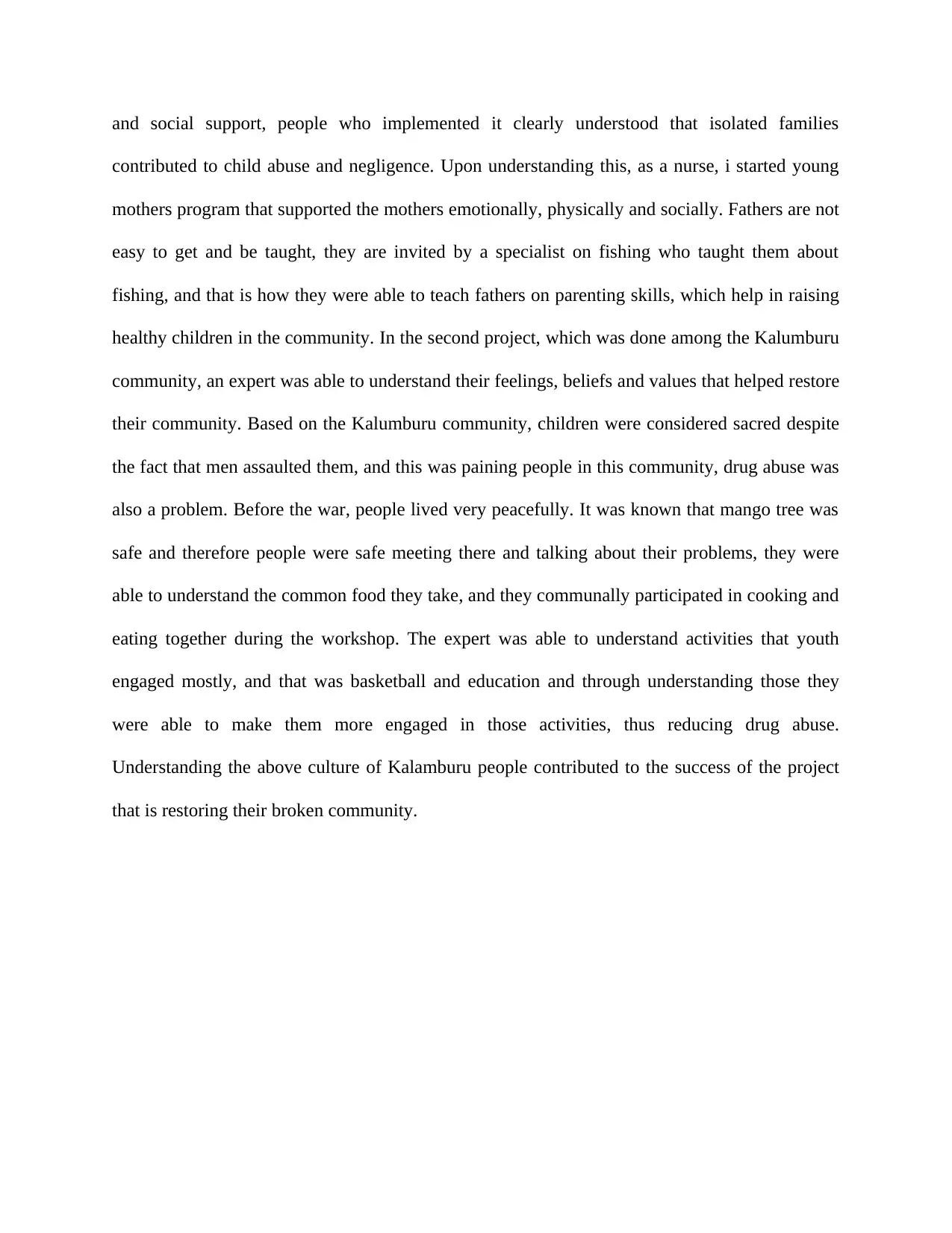
and social support, people who implemented it clearly understood that isolated families
contributed to child abuse and negligence. Upon understanding this, as a nurse, i started young
mothers program that supported the mothers emotionally, physically and socially. Fathers are not
easy to get and be taught, they are invited by a specialist on fishing who taught them about
fishing, and that is how they were able to teach fathers on parenting skills, which help in raising
healthy children in the community. In the second project, which was done among the Kalumburu
community, an expert was able to understand their feelings, beliefs and values that helped restore
their community. Based on the Kalumburu community, children were considered sacred despite
the fact that men assaulted them, and this was paining people in this community, drug abuse was
also a problem. Before the war, people lived very peacefully. It was known that mango tree was
safe and therefore people were safe meeting there and talking about their problems, they were
able to understand the common food they take, and they communally participated in cooking and
eating together during the workshop. The expert was able to understand activities that youth
engaged mostly, and that was basketball and education and through understanding those they
were able to make them more engaged in those activities, thus reducing drug abuse.
Understanding the above culture of Kalamburu people contributed to the success of the project
that is restoring their broken community.
contributed to child abuse and negligence. Upon understanding this, as a nurse, i started young
mothers program that supported the mothers emotionally, physically and socially. Fathers are not
easy to get and be taught, they are invited by a specialist on fishing who taught them about
fishing, and that is how they were able to teach fathers on parenting skills, which help in raising
healthy children in the community. In the second project, which was done among the Kalumburu
community, an expert was able to understand their feelings, beliefs and values that helped restore
their community. Based on the Kalumburu community, children were considered sacred despite
the fact that men assaulted them, and this was paining people in this community, drug abuse was
also a problem. Before the war, people lived very peacefully. It was known that mango tree was
safe and therefore people were safe meeting there and talking about their problems, they were
able to understand the common food they take, and they communally participated in cooking and
eating together during the workshop. The expert was able to understand activities that youth
engaged mostly, and that was basketball and education and through understanding those they
were able to make them more engaged in those activities, thus reducing drug abuse.
Understanding the above culture of Kalamburu people contributed to the success of the project
that is restoring their broken community.
⊘ This is a preview!⊘
Do you want full access?
Subscribe today to unlock all pages.

Trusted by 1+ million students worldwide
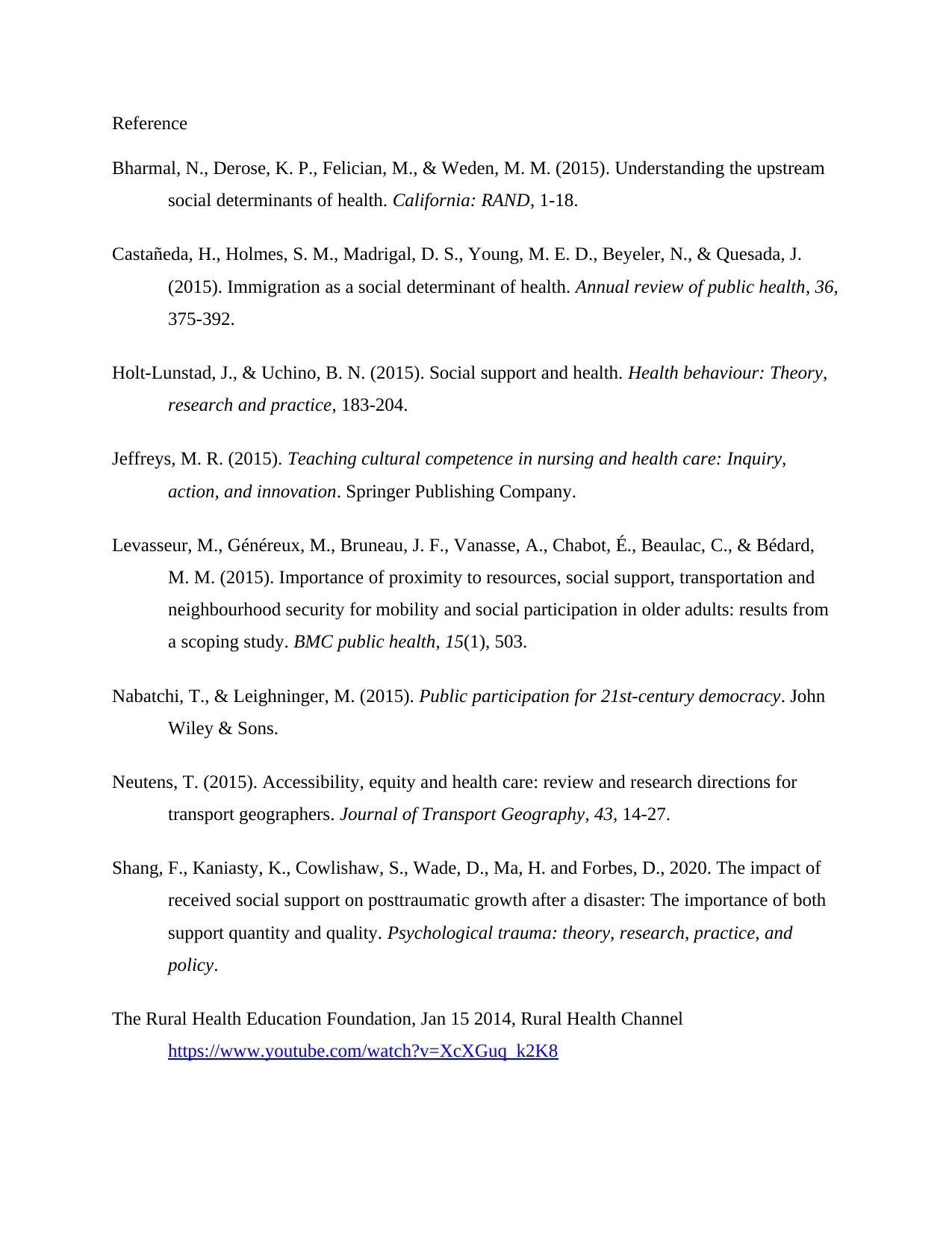
Reference
Bharmal, N., Derose, K. P., Felician, M., & Weden, M. M. (2015). Understanding the upstream
social determinants of health. California: RAND, 1-18.
Castañeda, H., Holmes, S. M., Madrigal, D. S., Young, M. E. D., Beyeler, N., & Quesada, J.
(2015). Immigration as a social determinant of health. Annual review of public health, 36,
375-392.
Holt-Lunstad, J., & Uchino, B. N. (2015). Social support and health. Health behaviour: Theory,
research and practice, 183-204.
Jeffreys, M. R. (2015). Teaching cultural competence in nursing and health care: Inquiry,
action, and innovation. Springer Publishing Company.
Levasseur, M., Généreux, M., Bruneau, J. F., Vanasse, A., Chabot, É., Beaulac, C., & Bédard,
M. M. (2015). Importance of proximity to resources, social support, transportation and
neighbourhood security for mobility and social participation in older adults: results from
a scoping study. BMC public health, 15(1), 503.
Nabatchi, T., & Leighninger, M. (2015). Public participation for 21st-century democracy. John
Wiley & Sons.
Neutens, T. (2015). Accessibility, equity and health care: review and research directions for
transport geographers. Journal of Transport Geography, 43, 14-27.
Shang, F., Kaniasty, K., Cowlishaw, S., Wade, D., Ma, H. and Forbes, D., 2020. The impact of
received social support on posttraumatic growth after a disaster: The importance of both
support quantity and quality. Psychological trauma: theory, research, practice, and
policy.
The Rural Health Education Foundation, Jan 15 2014, Rural Health Channel
https://www.youtube.com/watch?v=XcXGuq_k2K8
Bharmal, N., Derose, K. P., Felician, M., & Weden, M. M. (2015). Understanding the upstream
social determinants of health. California: RAND, 1-18.
Castañeda, H., Holmes, S. M., Madrigal, D. S., Young, M. E. D., Beyeler, N., & Quesada, J.
(2015). Immigration as a social determinant of health. Annual review of public health, 36,
375-392.
Holt-Lunstad, J., & Uchino, B. N. (2015). Social support and health. Health behaviour: Theory,
research and practice, 183-204.
Jeffreys, M. R. (2015). Teaching cultural competence in nursing and health care: Inquiry,
action, and innovation. Springer Publishing Company.
Levasseur, M., Généreux, M., Bruneau, J. F., Vanasse, A., Chabot, É., Beaulac, C., & Bédard,
M. M. (2015). Importance of proximity to resources, social support, transportation and
neighbourhood security for mobility and social participation in older adults: results from
a scoping study. BMC public health, 15(1), 503.
Nabatchi, T., & Leighninger, M. (2015). Public participation for 21st-century democracy. John
Wiley & Sons.
Neutens, T. (2015). Accessibility, equity and health care: review and research directions for
transport geographers. Journal of Transport Geography, 43, 14-27.
Shang, F., Kaniasty, K., Cowlishaw, S., Wade, D., Ma, H. and Forbes, D., 2020. The impact of
received social support on posttraumatic growth after a disaster: The importance of both
support quantity and quality. Psychological trauma: theory, research, practice, and
policy.
The Rural Health Education Foundation, Jan 15 2014, Rural Health Channel
https://www.youtube.com/watch?v=XcXGuq_k2K8
1 out of 7
Related Documents
Your All-in-One AI-Powered Toolkit for Academic Success.
+13062052269
info@desklib.com
Available 24*7 on WhatsApp / Email
![[object Object]](/_next/static/media/star-bottom.7253800d.svg)
Unlock your academic potential
Copyright © 2020–2025 A2Z Services. All Rights Reserved. Developed and managed by ZUCOL.





